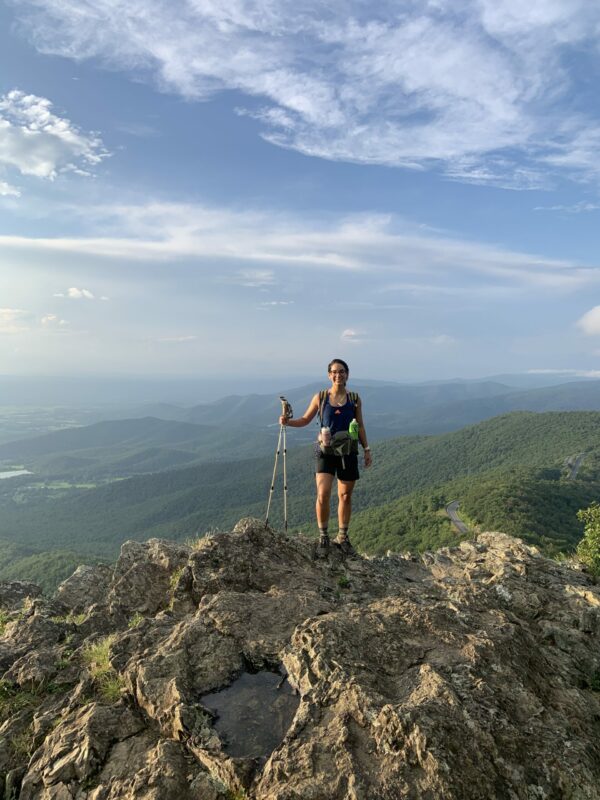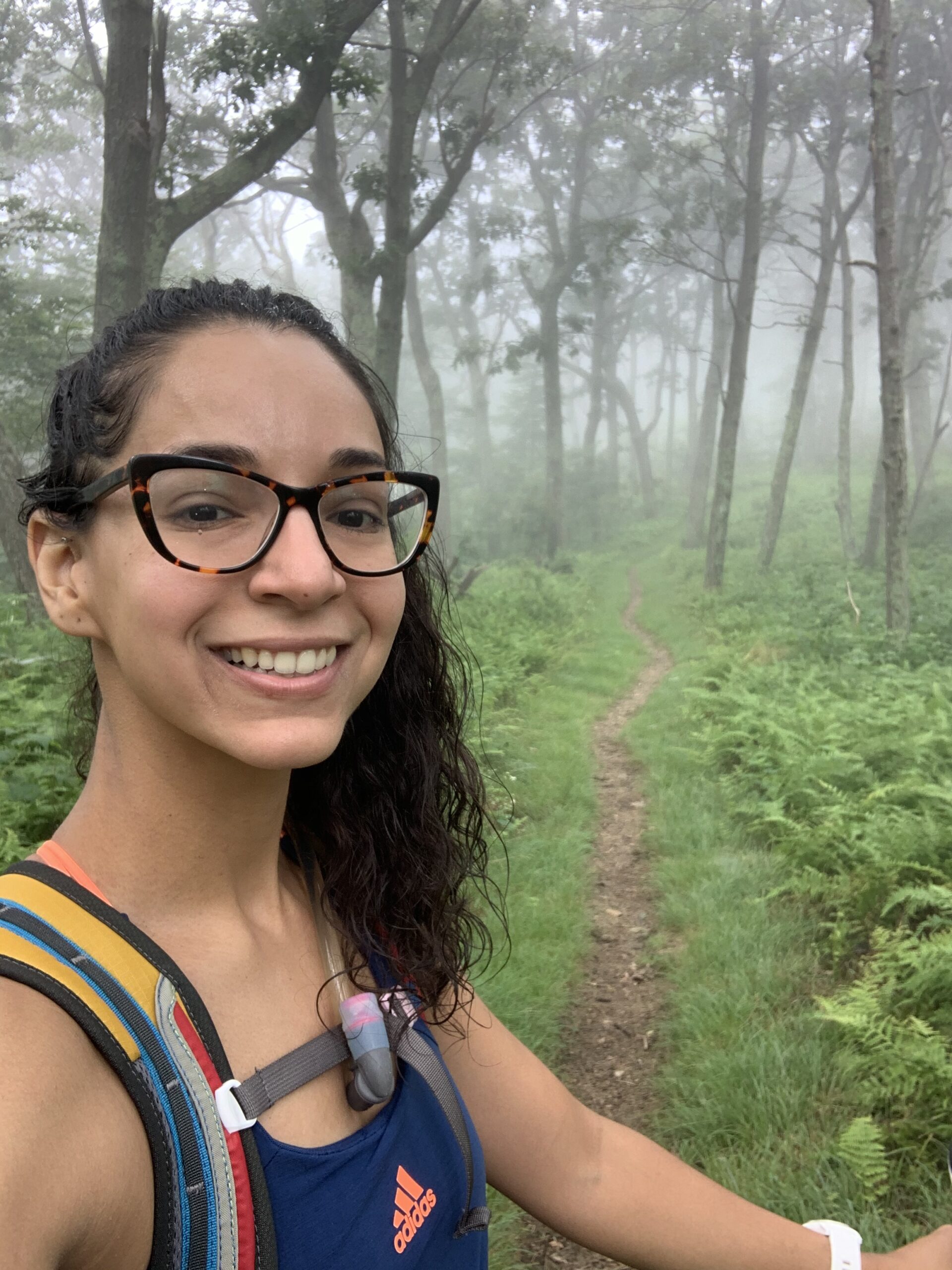In 2020, Ambassador Alex Garcia set out to complete her “60to100” – a fast and furious push through the 108 mile Shenandoah section of the Appalachian Trail – as a fundraiser for our Allies in the Outdoors campaign. We hopped on Zoom in late 2020 to learn more about the path that carried Alex to this challenging AT pursuit.
TCP: Hey Alex! Can you give us a quick refresher on your bio – who you are, and how your relationship to the outdoors been cultivated?
For sure! I was born and grew up in Puerto Rico – I’m from a small coastal town on the northwest coast called Aguadilla. I grew up in nature, in a way – in Puerto Rico, everyone goes to the beach. My parents have a farm inland from the coast, so I grew up back and forth between those two places.
I’ve thought about my relationship to the outdoors a lot since I’ve been doing more intense – well, I say intense – outdoor adventures. I try to pinpoint where this love and appreciation of nature started, and I think it was at my parents’ farm. They bought it when I was maybe 10 or 11, and there’s a creek that crosses it. My earliest memories of being there and exploring the land is walking up and down the stream with my dad and my two brothers. We’d be barefoot, and try to find freshwater lobsters and other types of animals, and just get to explore the land. And I think that’s where my love for the outdoors started. But I don’t have any specific experience in hiking, or backpacking, or things like that – I don’t know if anyone in Puerto Rico is raised with those sorts of experiences in the same way as in the US, or maybe those sorts of activities aren’t called the same thing in Puerto Rico.
I moved to the States in 2015, to Virginia, where I still live and work. When I moved here, I immediately gravitated toward the outdoors. I’ve mostly done everything I do by myself – I guess I usually haven’t found someone who wants to go as long or as fast, or who wants to do the crazy things I like to do. So it ends up being a choice between something I could miss out on or something I do alone. Mostly I’ve chosen to just go at it solo!
Interesting! We’re curious about the “fast” thing – what sparked your interest in fast adventures?
It’s been a long road, and I’m not at the end yet – this is an evolving route that I’m paving for myself. I’m naturally athletic, so when I started hiking, I had a pretty good pace and I did relatively well. Since starting, I’ve traveled in the US and some outside and done outdoors adventures, and I think it’s a very well-balanced approach of planning and preparation that gets me into a really good spot to execute, according to my plan and my training.
I can say that it all starts with a mountain – in 2017, my then-boyfriend, now-husband and I decided to climb Mt. Kilimanjaro. He’s not a hiker, so this was a very important thing for us to do together! Once we decided to do it, I took training very seriously. I have some background in sports training, so I devised a plan for myself. It involved backcountry camping for the first time solo, obstacle course racing, and other things. We completed our goal and summited, and I think that not only the experience of climbing the mountain, but also the preparation really changed my whole viewpoint of how to approach the outdoors. After reaching that goal, I realized it was a whole series of accomplishments that took me to the summit.

I decided to start what was calling then “difficult pursuits” – every year I’m going to try to do something that’s progressively more difficult than the year before. I felt like Kilimanjaro was pretty hard to beat! The next year I trained to do a solo single day Rim to Rim in the Grand Canyon. I had no background in running, but I trained really hard, and I did it! And in a relatively good time, given that I was hiking.
The next year, I completed a solo single day Presidential Traverse – a pretty intense 20 mile hike, and I trained really hard for it, and as always was very adamant and detailed in my planning, and I achieved the goal, again in a pretty good time. So I was feeling really good about myself last year [in 2019]. So I said this year [2020], I wanted to take it up a notch: my goals were to climb Mt. Whitney, and to have my first expedition trip and attempt Mt. Rainier. Obviously, with the pandemic and its effects, I watched those goals start falling apart, and it was a low point in May to realize that these things I’d been planning on were not going to happen this year. I got a notification that the September 2020 Rainier expedition I’d signed up for was cancelled.
That night with my husband, I said “I’m so sad, I don’t know what to do.” He said, “Why not things about things you can do closer?” And I realized that I’d been thinking about doing the AT Shenandoah section in a single push – I didn’t want to sleep, I just wanted to do it in one go and see how long it takes me. My husband was like “Alex? Maybe you should try a little less intense?” And I was like “OK, OK, so what about just going all out for 24 hours and seeing how far I can go?” And he was like “Alex, maybe you should give yourself more time? And I was like OK, OK, what about doing it just in a weekend?” And he agreed that that seemed like something I could plan and prepare for. Even though this had been something I had been expecting to do later, I realized that maybe in light of everything going on with the pandemic, this was the right moment to go for it.
TCP: It’s so inspiring that you took the experience of your plans being cancelled and turned that into an opportunity to grow and to push yourself in a different way.
Yeah – I’m pretty adaptable. It’s been a long process, and a weird one, to move to the US. Even though my experience growing up was so different from my husband’s or most of my friends, I still grew up with a pretty Americanized background and in a very privileged family. When I moved here, I had to come to terms with the differences and the similarities. Once you start a life here, I dealt with an aspect of culture shock. I think that forced me to develop my adaptability. When something happens that throws me off, here’s what I do: let’s be honest, I grieve about it for a day or two and feel sorry for myself! And I think it’s important to feel those emotions. But then I think I can fairly quickly get through that and shrug my shoulder and say “Ok, how are we going to move about this now.”
TCP: We’re interested in the cultural shock aspect of moving to the States, particularly in your outdoor pursuits. You mentioned growing up that there wasn’t the same language used to describe thing – what has that transition been like for you, particularly?
It’s been interesting. My mom is a force of nature and loves the outdoors. But we grew up with no gear. If anything, we had one giant Coleman tent. In Puerto Rico, we don’t use terms like “hiking,” and there isn’t necessarily a network of trails. People just put on their shoes – not fancy hiking boots – and explore their island. The language I use to describe myself here is very different. I would never call myself “outdoorsy” in Spanish, in Puerto Rico. And the elitism that is attached to gear here in the US feels very abstract to me.
It also has been interesting to come to terms with my identity as a woman of color in the US, which is something I hadn’t contemplated growing up in Puerto Rico. And people sometimes ask me about my accent, which has been a strange experience that I didn’t expect, because my accent is mild. It’s not an obstacle, but more like “Why do you care?”

TCP: It’s so interesting to think about all of these levels of identification – how we self-identify, how people identify us, etc. Would you identify yourself as an outdoor athlete now, having achieved some of these goals you’ve shared about?
I think I’m starting to use it more often. People try to put me in a bucket and figure out what I’m about. I take pride in how I approach the outdoors – with my training, monitoring my performance, and other things – so there is an element of athleticism that I can see. So now I’m starting to say “yeah, I’m an outdoor athlete”…even though I still don’t really knows what it means! I realize that I need to continue to define it better for myself and for others.
I’ll also say this: I look up to many “true” outdoor athletes, and especially women – these women who go after Fastest Known Times, or do these crazy multi-day adventure races. I admire them, and in some ways maybe I want to get there someday. But I’m just taking it one day at a time, taking a very methodical and phased out approach to my development in the outdoors, and we’ll see where that goes. But I’m starting to call myself an adventure athlete, and I do know what I think a true adventure athlete looks like. I know I’m not there yet, but I do have my sights on it.
TCP: Can you talk a bit about the mental versus physical challenges of the events that you’ve completed?
It’s a combination of both, for sure. I can say that doing the 108 miles of the AT in two days was definitely the hardest thing I’ve ever done both physically and mentally. I think it’s about finding how far I can push myself, and why I’m able to push myself in those moments – it’s been a very eye opening experience for me. When I look back, previous things I’ve done have had a mental challenge, but I think as the miles get longer and you’re alone for longer periods of time, the mental challenge gets bigger. My previous goals have been single day challenges. Once you get into multi-day events, dealing with tiredness, bad weather, loneliness – I think that’s when the mental gets more challenging than the physical aspects.
TCP: In those low points, what are some of the things you go to in order to keep yourself in a good mental space, or to not let yourself get too down?
Well, I try not to listen to anything on the trail because I want to be completely in the environment and aware of my surroundings. Out of the about 40 hours I spent on my AT project, I listened to podcasts for about 2 hours. Early in the morning when it’s still dark outside, I like to break the silence. Even though people might think I’m super confident, I do get scared – I’m scared of bears, I’m scared of the dark, ha! – and so it’s nice to break the silence, and maybe this sounds crazy, but I like to talk to the forest. I say good morning, and I ask it to be nice to me during the day. I just like to make peace with the forest, because I do feel like I’m part of it when I’m out there. Breaking the silence and hearing my own voice calms me.

I’ve learned recently that when I start to get in that real pain cave and start to doubt myself, I have two things I would say to myself: “One more step,” which I know many people say to themselves. The other mantra is “Bailing is not voluntary.” You only exit out of sheer necessity – like if you break a foot! I got a bad hornet sting early into the AT segment, and I haven’t been stung before, so I immediately got nervous about an allergic reaction – and I was only seven miles into this hike! I spent a lot of time thinking about what bailing would look like, and decided that I would not bail voluntarily – that I would finish even if I go beyond the time limit I’d set, even if I’m crawling – if there is no medical or emergency reason to exit the trail, I’m going to keep going. Having that mindset and making that commitment has been helpful to me once I reach a point of feeling really uncomfortable.
TCP: Leading up to your AT Challenge, you did an amazing job of publicizing your plans and the fact that it would be a fundraiser for our Allies in the Outdoor campaign. We know from personal experience that can change your relationship with an adventure. Sometimes it can add a different dimension to it in terms of motivation to get it done, because so many people are watching. Can you share what you experienced in this vein?
One thing that I really enjoyed about publicizing the fundraising it is that I told a lot of people about this adventure before I did it. On previous big adventures I’ve done, like the Rim to Rim or the Presidential Traverse, I didn’t tell many people ahead of time – I think because I was afraid of failing. This time, because I felt really strongly about the “Allies in the Outdoors” fundraiser that I really didn’t care if I failed or not. Sure, it was a great adventure, and it could be a bigger stepping stone for adventures in the future – but that wasn’t the point! It was more rooted in something of value and not just about me, and that changed the whole experience in a really fulfilling way.

Alex Garcia
In 2020, Ambassador Alex Garcia set out to complete her “60to100” – a fast and furious push through the 108 mile Shenandoah section of the Appalachian Trail – as a fundraiser for our Allies in the Outdoors campaign. See Alex's ambassador page.
